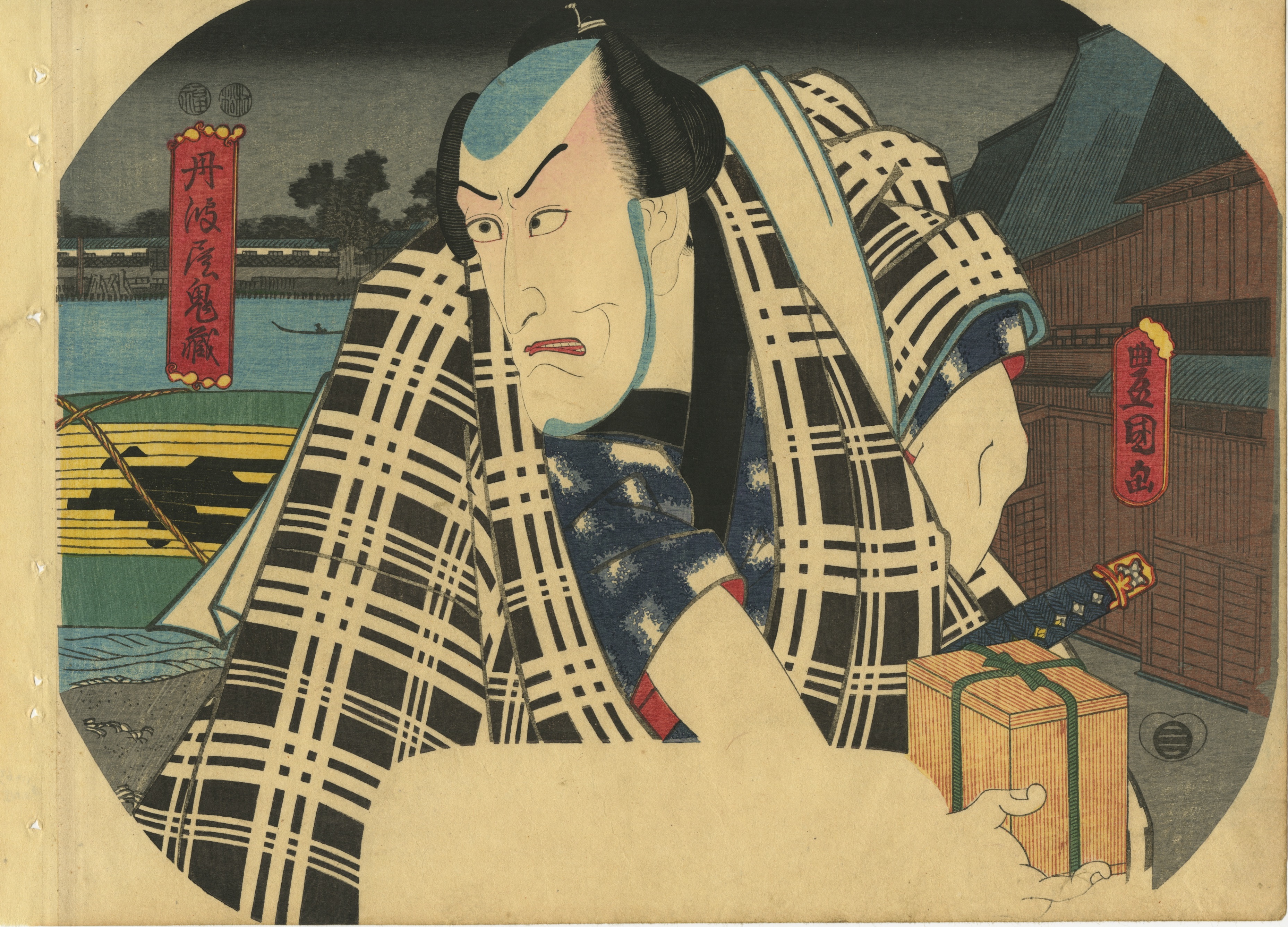-
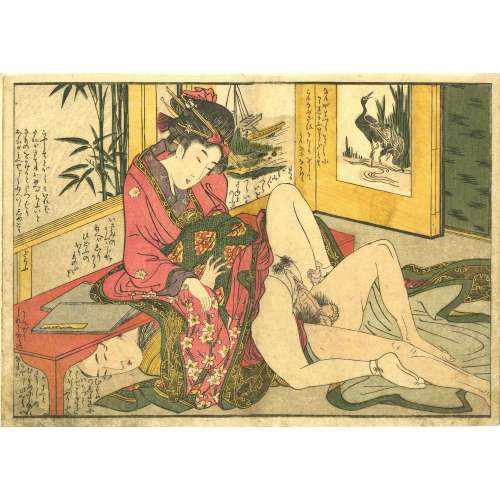 Kitagawa Utamaro. Illustration from book Ehon koi no Onamaki, published in 1799. Reference found by Chris Uhlenbeck: he found one of the designs in Hayashi Yoshikazu's 20-volume set Edo makura-e shi shusei: Kitagawa Utamaro. Size: Chuban (25.5 x 18.5 cm), two book pages glued together.
Kitagawa Utamaro. Illustration from book Ehon koi no Onamaki, published in 1799. Reference found by Chris Uhlenbeck: he found one of the designs in Hayashi Yoshikazu's 20-volume set Edo makura-e shi shusei: Kitagawa Utamaro. Size: Chuban (25.5 x 18.5 cm), two book pages glued together. -
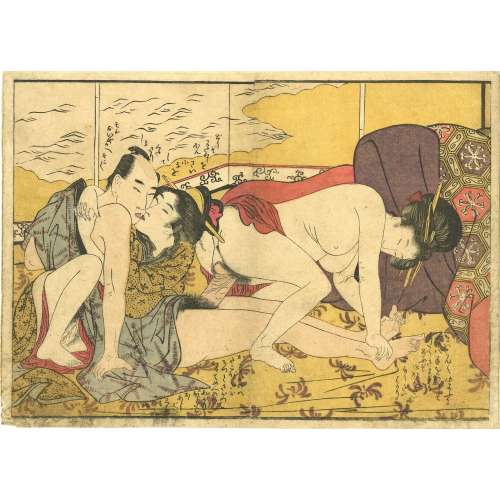 Kitagawa Utamaro. Illustration from the book Ehon koi no Onamaki. Cited at Hayashi Yoshikazu's 20-volume set Edo makura-e shi shusei: Kitagawa Utamaro. Size: Chuban (25.5 x 18.5 cm), two book pages glued together.
Kitagawa Utamaro. Illustration from the book Ehon koi no Onamaki. Cited at Hayashi Yoshikazu's 20-volume set Edo makura-e shi shusei: Kitagawa Utamaro. Size: Chuban (25.5 x 18.5 cm), two book pages glued together. -
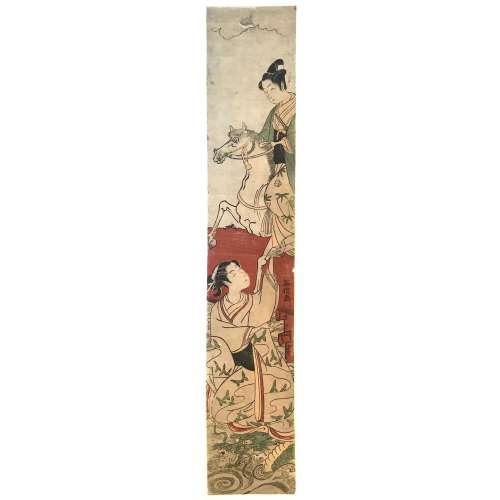 Santō Kyōden (山東 京伝, September 13, 1761 Edo – October 27, 1816) was a Japanese poet, writer and artist in the Edo period. He studied ukiyo-e under master Kitao Shigemasa (北尾 重政) [see SVJP-0006], and began illustrating kibyōshi under the pseudonym of Kitao Masanobu (北尾 政寅).
Santō Kyōden (山東 京伝, September 13, 1761 Edo – October 27, 1816) was a Japanese poet, writer and artist in the Edo period. He studied ukiyo-e under master Kitao Shigemasa (北尾 重政) [see SVJP-0006], and began illustrating kibyōshi under the pseudonym of Kitao Masanobu (北尾 政寅).Signed: Masunobu ga.
"Parody of the Nō Play Chōryō" (elsewhere) or "Parody of Huáng Shigōng and Zhāng Liáng" (David Waterhouse, The Harunobu Decade, Hotei Publishing, 2013, v. 2, №651). "The story [...] is about an encounter between the Chinese government minister Chôryô (Zhāng Liáng) and the legendary elder Kôsekikô (Huáng Shigōng) in the 3rd century BC. While riding a mule across a bridge, Kôsekikô dropped his sandal. Chôryô returned it to him. As a reward, Kôsekikô gave Chôryô a book of military strategy. Later, Chôryô helped to establish the Han Dynasty (207 BC-AD 220)." [The Walters Art Museum]References:
Waterhouse, The Harunobu Decade (2013), #651; Ukiyo-e shûka supp. 2 (1982), pl. 625; Pins, The Japanese Pillar Print (1982), #274/p.145; J. Kurth, Die Geschichte..., vol. II, Leipzig, 1928; S. Kikuchi, Ukiyo-e, 1966.
-
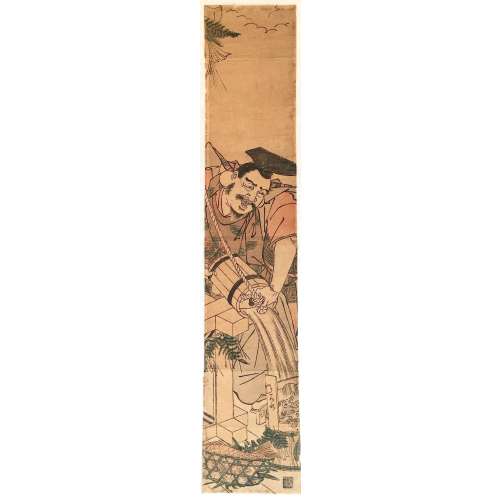 Ebisu drawing wakamizu, the first water drawn from a well on the New Year. Kitao Shigemasa (北尾 重政, 1739 – 8 March 1820). Signed: Shigemasa. Publisher's mark: Nishimuraya Yohachi.
Ebisu drawing wakamizu, the first water drawn from a well on the New Year. Kitao Shigemasa (北尾 重政, 1739 – 8 March 1820). Signed: Shigemasa. Publisher's mark: Nishimuraya Yohachi.References:
Jacob Pins #547 [p.217] - Ebisu drawing wakamizu, the first water drawn from a well on the New Year. TNM II (Tokyo National Museum Catalogue vol. 2) #1373.
-
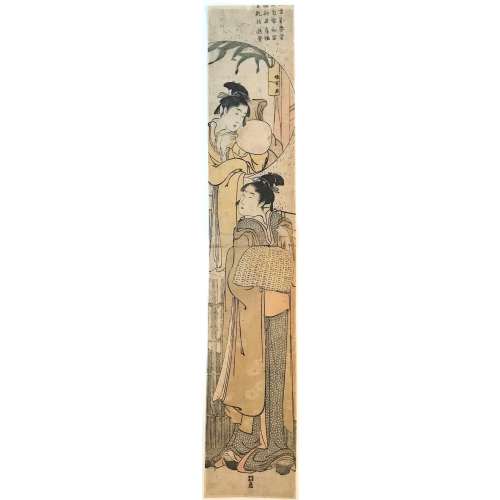 Woman Looking out a Round Window at a Woman with a Komusō Hat.
Woman Looking out a Round Window at a Woman with a Komusō Hat.Artist Koikawa Harumasa (a.k.a. Banki): fl. 1801–18. Wikipedia: Koikawa Harumasa (恋川 春政; active 1800–1820), later called Banki Harumasa (晩器 春政). Associated with Katsukawa school.
Signed: Banki ga (on the bamboo flower container in the background). Censor's seal: kiwame. Mark of unidentified publisher, Genshoku #1017; Marks U084 Ibiko, p. 387.
References:
Jacob Pins #828.
-
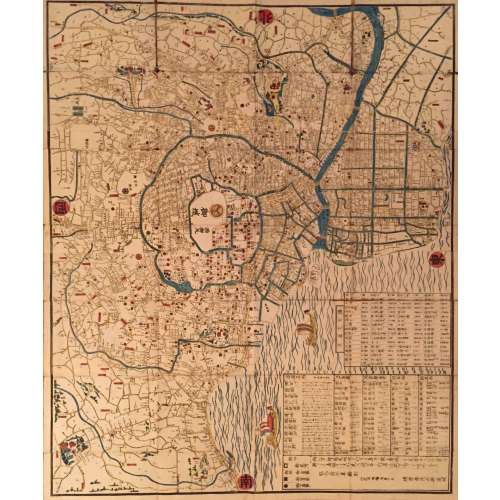
-
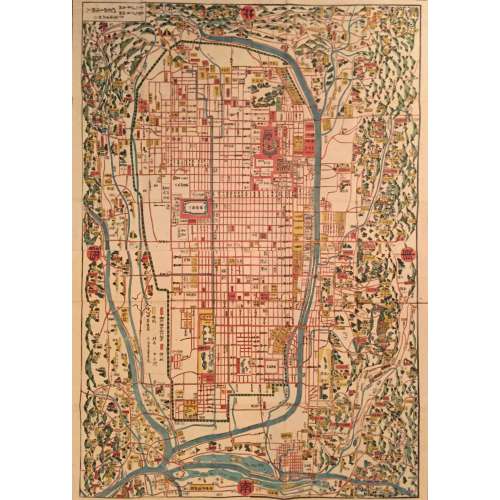
-
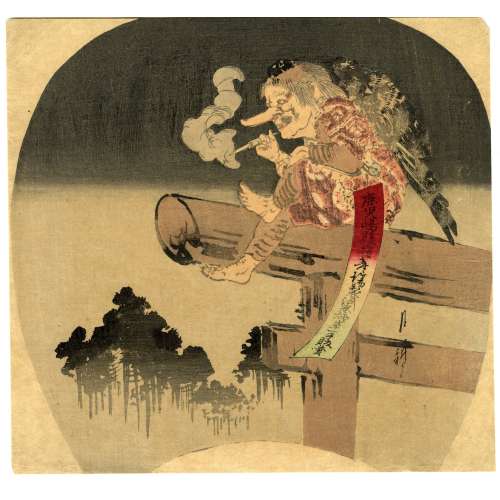 Ogata Gekkō [尾形月耕] (Japanese, 1859 – 1920). An uchiwa-e (fan-print) of advertisement of tobacco of Kagoshima Prefecture, c. 1890 (Meiji Period). Barefoot Tengu* is sitting on a torii (entrance to a Shinto shrine), smoking a cigarette through a mouthpiece. _______ * Tengu [天狗] (heavenly dog) is a type of legendary creature found in Japanese folk religion and are also considered a type of Shinto god (kami) or yōkai (supernatural beings).
Ogata Gekkō [尾形月耕] (Japanese, 1859 – 1920). An uchiwa-e (fan-print) of advertisement of tobacco of Kagoshima Prefecture, c. 1890 (Meiji Period). Barefoot Tengu* is sitting on a torii (entrance to a Shinto shrine), smoking a cigarette through a mouthpiece. _______ * Tengu [天狗] (heavenly dog) is a type of legendary creature found in Japanese folk religion and are also considered a type of Shinto god (kami) or yōkai (supernatural beings). -
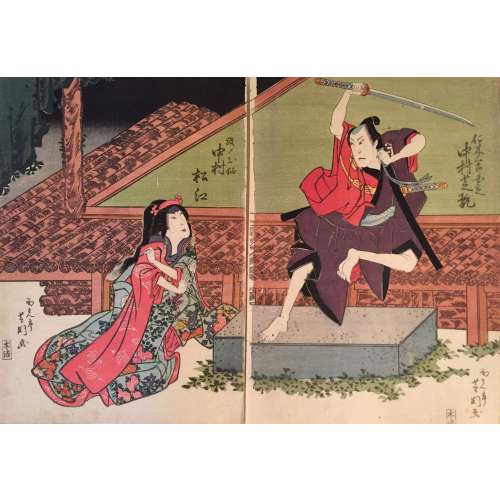 Saikotei Shibakuni (active 1821-1826). Osaka school. Play: Kinoshitakage Hazuma Gassen. Theatre: Nakamura-za /Naka-za (Osaka). Date: 7/1826. Horizontal oban diptych. SV: Nakamura Matsue III (Nakamura Tomijuro II) as female, Nakamura Utaemon III (Nakamura Shikan I) as a male. Publisher: Honya Seishichi [Marks 25-527 | 123f], Honsei, 1817-1838.
Saikotei Shibakuni (active 1821-1826). Osaka school. Play: Kinoshitakage Hazuma Gassen. Theatre: Nakamura-za /Naka-za (Osaka). Date: 7/1826. Horizontal oban diptych. SV: Nakamura Matsue III (Nakamura Tomijuro II) as female, Nakamura Utaemon III (Nakamura Shikan I) as a male. Publisher: Honya Seishichi [Marks 25-527 | 123f], Honsei, 1817-1838. -
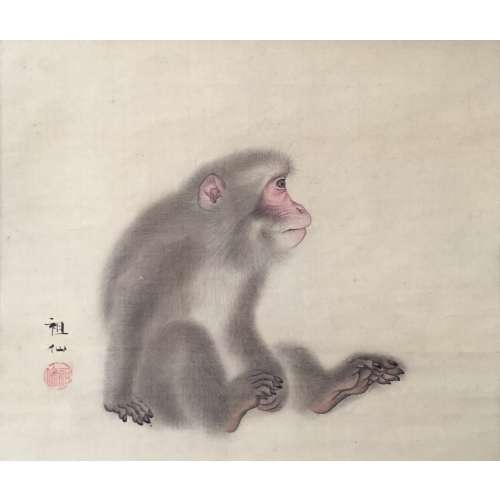 Mori Sosen (1747-1821). Seated Monkey. Hanging scroll painting. Ink and colour on silk. Signed: Sosen. Sealed: Sosen. 28.8 x 33.3 cm.
Mori Sosen (1747-1821). Seated Monkey. Hanging scroll painting. Ink and colour on silk. Signed: Sosen. Sealed: Sosen. 28.8 x 33.3 cm. -
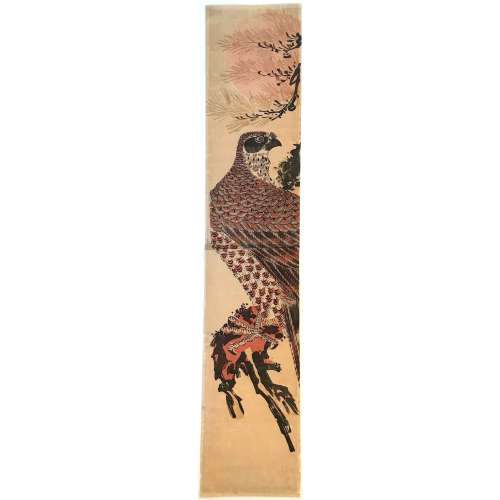 The print lacks signature. It is attributed by some to Suzuki Harunobu and by the others to Isoda Koryūsai.
The print lacks signature. It is attributed by some to Suzuki Harunobu and by the others to Isoda Koryūsai.Attributed to Koryūsai: Pins #517/p.209, c. 1775 [AIC II: Clarence Buckingham Collection, 1925.2772], Ukiyo-e Taisei IV; Vignier & Inada, 1911; Ritsumeikan University Z0165-239.
Attributed to Harunobu: Pins #239/p.132.; BM 1906,1220,0.85;
-
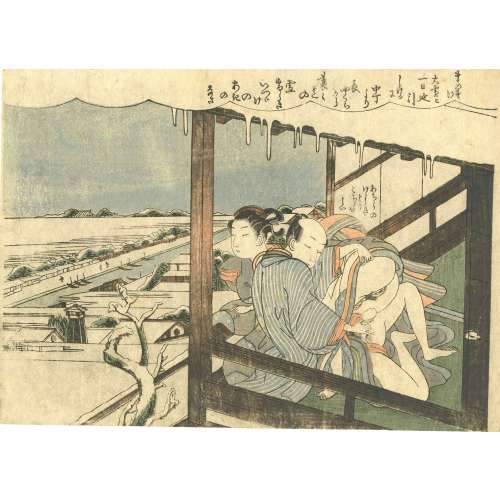 Unsigned print, attributed to Suzuki Harunobu. Erotic scene on open veranda with a winter landscape on background.
Unsigned print, attributed to Suzuki Harunobu. Erotic scene on open veranda with a winter landscape on background. -
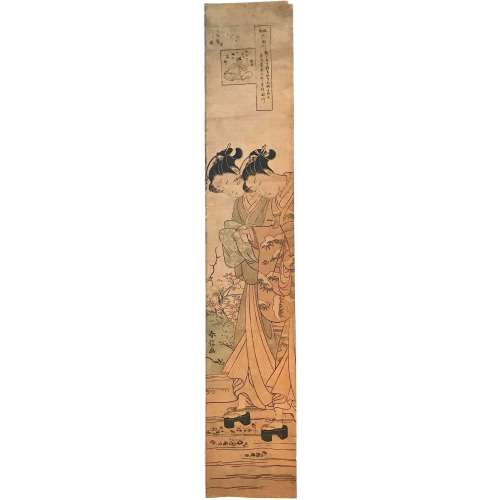 Suzuki Harunobu (鈴木 春信; c. 1725 – 15 July 1770).
Suzuki Harunobu (鈴木 春信; c. 1725 – 15 July 1770).The Ide Jewel River, a Famous Place in Yamashiro Province (Ide no Tamagawa, Yamashiro no meisho), from the series The Six Jewel Rivers in Popular Customs (Fûzoku Mu Tamagawa).
Signed: Harunobu gaInscription - Poem: Koma tomete/ nao mizu kawan/ yamabuki no/ hana no tsuyu sou/ Ide no Tamagawa
References:MFA # 21.4540.
Waterhouse cat. #562; Pins, The Japanese Pillar Print (1982), #139; Ukiyo-e shûka 4 (1979), list #795.4, and supp. 2 (1982), pl. 565; Gentles, AIC cat. II (1965), p. 125, #201.
-
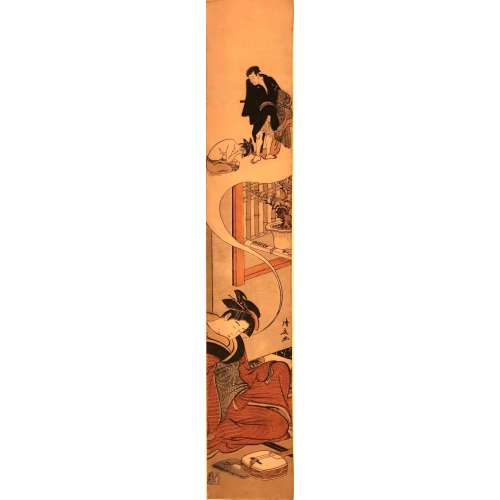 Torii Kiyonaga (1752-1815) Color woodblock print: hashira-e, 68.9 x 12.1 cm. DATE: 1783. Signed: Kiyonaga ga Publisher: Eijudō (Nishimuraya Yohachi) "Young musician dreams of being abducted by a ruffian. Long hours on duty have exhausted this young musician who sits sleeping with her shamisen and book placed on the ground in front of her. In her dream, she is being abducted by a ruffian who has stripped her of her clothing" [LIB-1474.2018: Important Japanese prints from the collection of Henry Steiner. Catalogue № 14. — NY: Sebastian Izzard LLC, 2018.]
Torii Kiyonaga (1752-1815) Color woodblock print: hashira-e, 68.9 x 12.1 cm. DATE: 1783. Signed: Kiyonaga ga Publisher: Eijudō (Nishimuraya Yohachi) "Young musician dreams of being abducted by a ruffian. Long hours on duty have exhausted this young musician who sits sleeping with her shamisen and book placed on the ground in front of her. In her dream, she is being abducted by a ruffian who has stripped her of her clothing" [LIB-1474.2018: Important Japanese prints from the collection of Henry Steiner. Catalogue № 14. — NY: Sebastian Izzard LLC, 2018.]The Japanese Pillar Print. Hashira-e. Jacob Pins. Foreword by Roger Keyes. Robert G. Sawers Publishing, London, 1982 [LIB-1543.2018 in this collection] -> page 262 №703: A young woman dreaming of rape and robbery. 1783. Hirano.
MFA: ACCESSION NUMBER 21.5546: Young Woman Music Teacher Dreaming of a Robbery [追剥の夢を見る三味線師匠]. Edo period, about 1783 (Tenmei 3). Artist Torii Kiyonaga (1752–1815), Publisher Nishimuraya Yohachi (Eijudô). Harvard Museums Object Number 1916.586: Female Musician Dreaming of Robbery. Edo period, circa 1783. Torii Kiyonaga, Japanese (1752 - 1815) . Published by Nishimuraya Yohachi. -
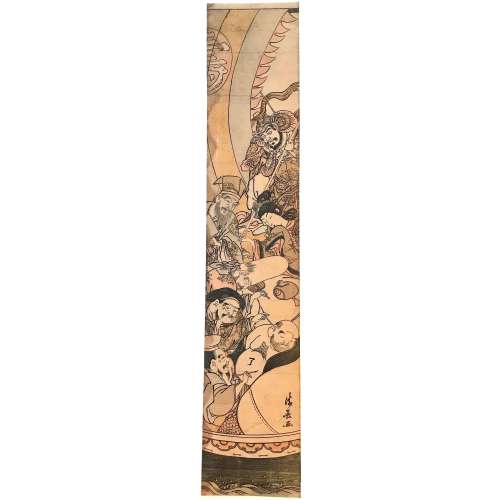 Torii Kiyonaga (鳥居 清長; 1752 – June 28, 1815) Signed: Kiyonaga ga (清長画)
Torii Kiyonaga (鳥居 清長; 1752 – June 28, 1815) Signed: Kiyonaga ga (清長画)References: No references whatsoever, not in Pins.
-
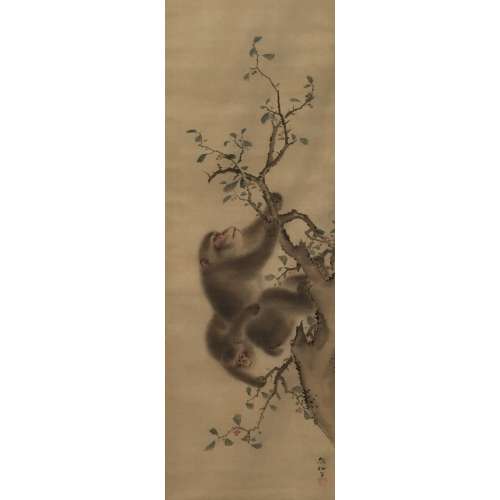 Mori Sosen (1747-1821). Two Monkeys Hanging From Branches. Hanging Scroll Painting. Ink and colour on silk. Signed: Sosen. Sealed: Sosen.
Mori Sosen (1747-1821). Two Monkeys Hanging From Branches. Hanging Scroll Painting. Ink and colour on silk. Signed: Sosen. Sealed: Sosen. -
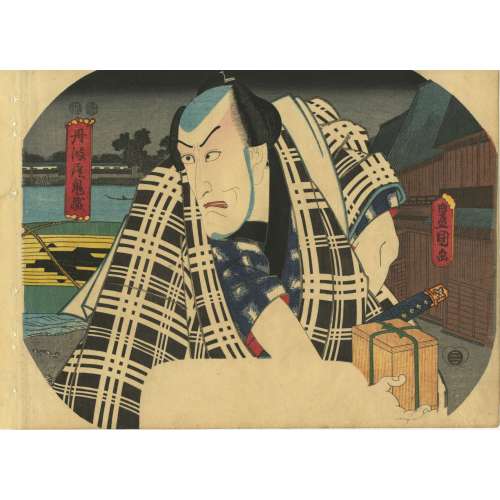 Artist: Utagawa Kunisada [歌川 国貞] a.k.a. Utagawa Toyokuni III [三代歌川豊国] (Japanese, 1786 – 1865). Signed: Toyokuni ga [豊国 画] in a red toshidama cartouche. Actor: Ichikawa Danjūrō VII 市川団十郎 (Japanese, 1791 – 1859); other names: Ichikawa Ebizō V, Ichikawa Hakuen II, Ichikawa Shinnosuke I. Character: Tanbaya Onizo [丹波屋鬼蔵] Play: Koi Bikyaku Yamato Orai [恋飛脚大和往来] Performance: Kawarasaki Theatre [河原崎座] in the 2nd month of 1851. Double nanushi censor seals: Fuku & Muramatsu, from 3rd month of Kaei 2 to 11th month of Kaei 4 (1849-51). Another fan print from the pair SVJP-0212-2.2016: Sawamura Chōjūrō V as Kameya Chubei.
Artist: Utagawa Kunisada [歌川 国貞] a.k.a. Utagawa Toyokuni III [三代歌川豊国] (Japanese, 1786 – 1865). Signed: Toyokuni ga [豊国 画] in a red toshidama cartouche. Actor: Ichikawa Danjūrō VII 市川団十郎 (Japanese, 1791 – 1859); other names: Ichikawa Ebizō V, Ichikawa Hakuen II, Ichikawa Shinnosuke I. Character: Tanbaya Onizo [丹波屋鬼蔵] Play: Koi Bikyaku Yamato Orai [恋飛脚大和往来] Performance: Kawarasaki Theatre [河原崎座] in the 2nd month of 1851. Double nanushi censor seals: Fuku & Muramatsu, from 3rd month of Kaei 2 to 11th month of Kaei 4 (1849-51). Another fan print from the pair SVJP-0212-2.2016: Sawamura Chōjūrō V as Kameya Chubei.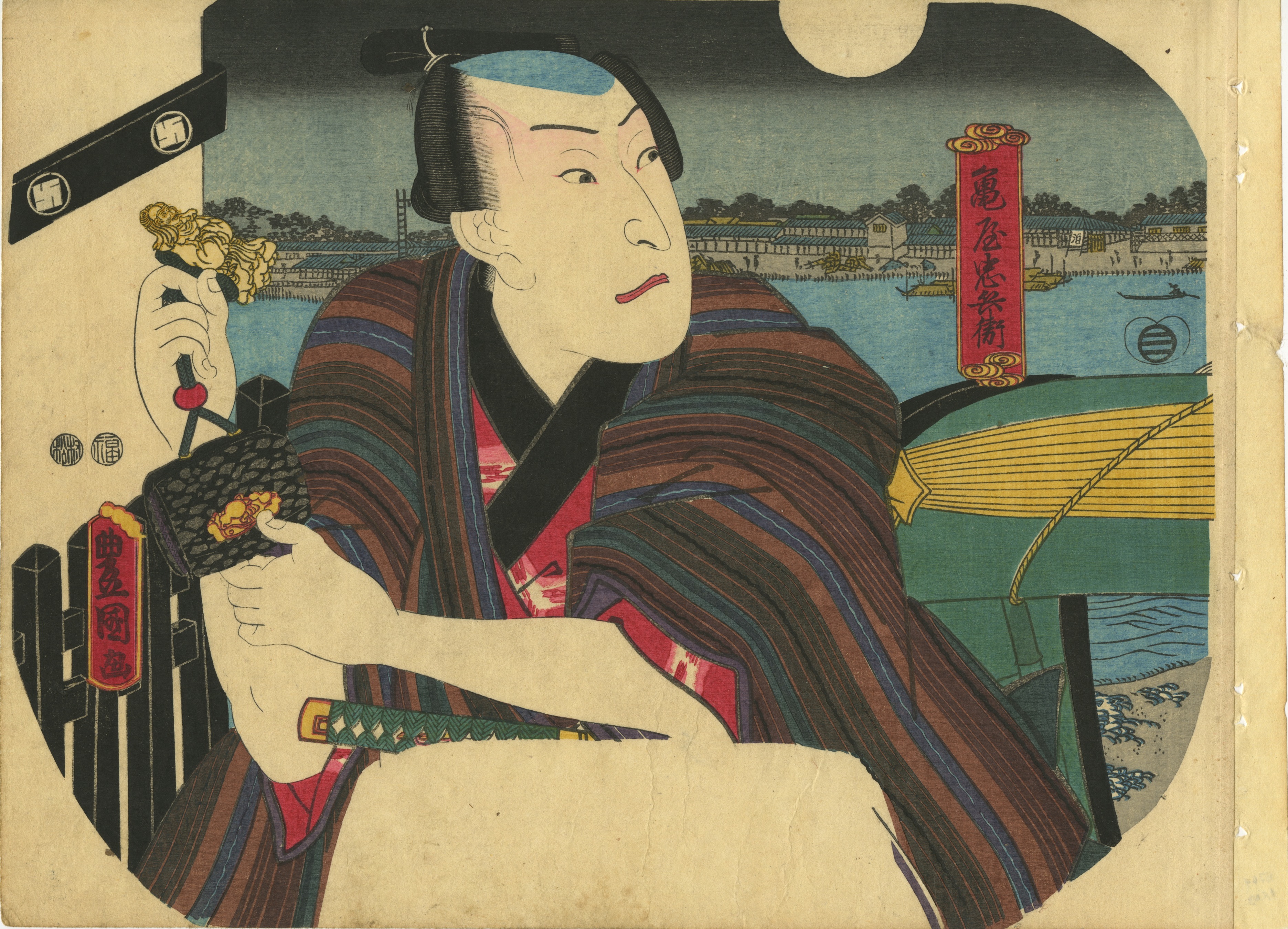
-
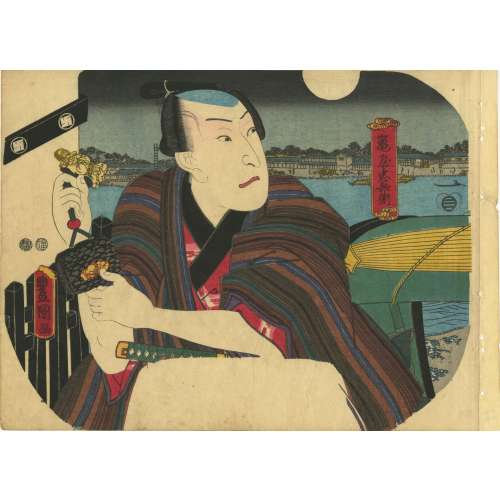 Artist: Utagawa Kunisada [歌川 国貞] a.k.a. Utagawa Toyokuni III [三代歌川豊国] (Japanese, 1786 – 1865). Signed: Toyokuni ga [豊国 画] in a red toshidama cartouche. Actor: Sawamura Gennosuke II [沢村源之助] (Japanese, 1802/7 – 1853); other names: Suketakaya Takasuke III, Sawamura Chōjūrō V [沢村長十郎], Sawamura Tosshō I, Sawamura Genpei I. Character: Kameya Chubei [亀屋忠兵衛] Play: Koi Bikyaku Yamato Orai [恋飛脚大和往来] Performance: Kawarasaki Theatre [河原崎座] in the 2nd month of 1851. Double nanushi censor seals: Fuku & Muramatsu, from 3rd month of Kaei 2 to 11th month of Kaei 4 (1849-51). Another fan print from the pair SVJP-0212-1.2016: Ichikawa Ebizō V as Tanbaya Onizo / Fan print, 1851.
Artist: Utagawa Kunisada [歌川 国貞] a.k.a. Utagawa Toyokuni III [三代歌川豊国] (Japanese, 1786 – 1865). Signed: Toyokuni ga [豊国 画] in a red toshidama cartouche. Actor: Sawamura Gennosuke II [沢村源之助] (Japanese, 1802/7 – 1853); other names: Suketakaya Takasuke III, Sawamura Chōjūrō V [沢村長十郎], Sawamura Tosshō I, Sawamura Genpei I. Character: Kameya Chubei [亀屋忠兵衛] Play: Koi Bikyaku Yamato Orai [恋飛脚大和往来] Performance: Kawarasaki Theatre [河原崎座] in the 2nd month of 1851. Double nanushi censor seals: Fuku & Muramatsu, from 3rd month of Kaei 2 to 11th month of Kaei 4 (1849-51). Another fan print from the pair SVJP-0212-1.2016: Ichikawa Ebizō V as Tanbaya Onizo / Fan print, 1851.